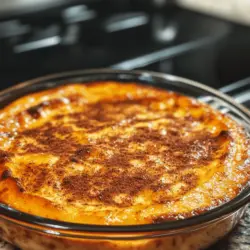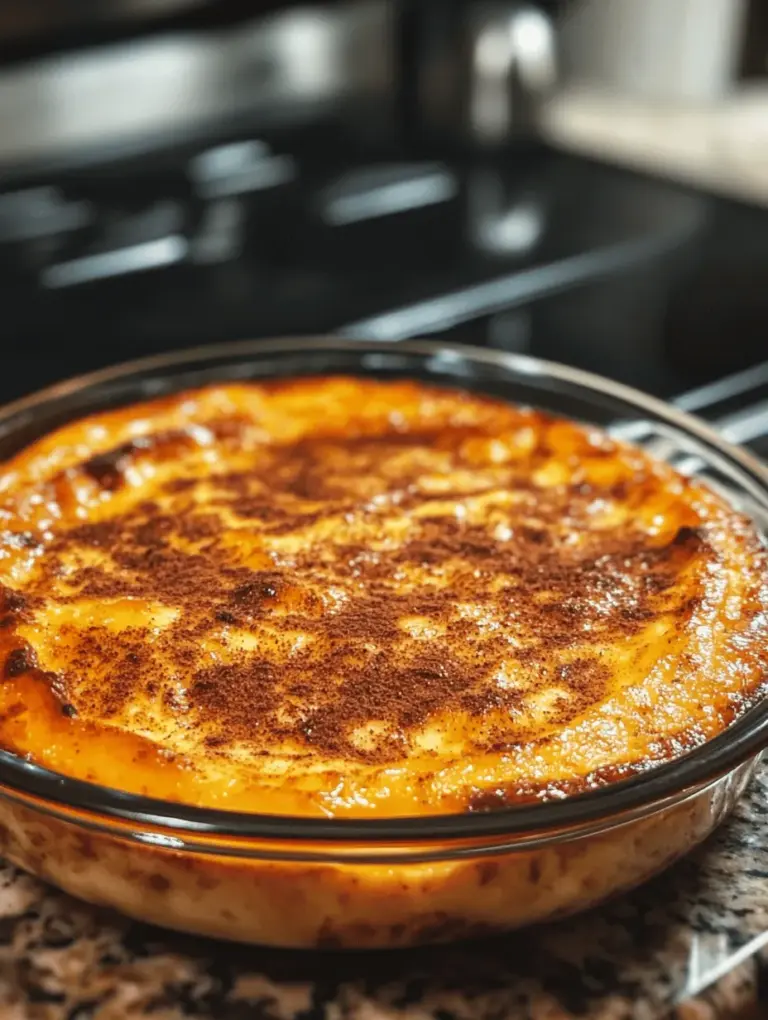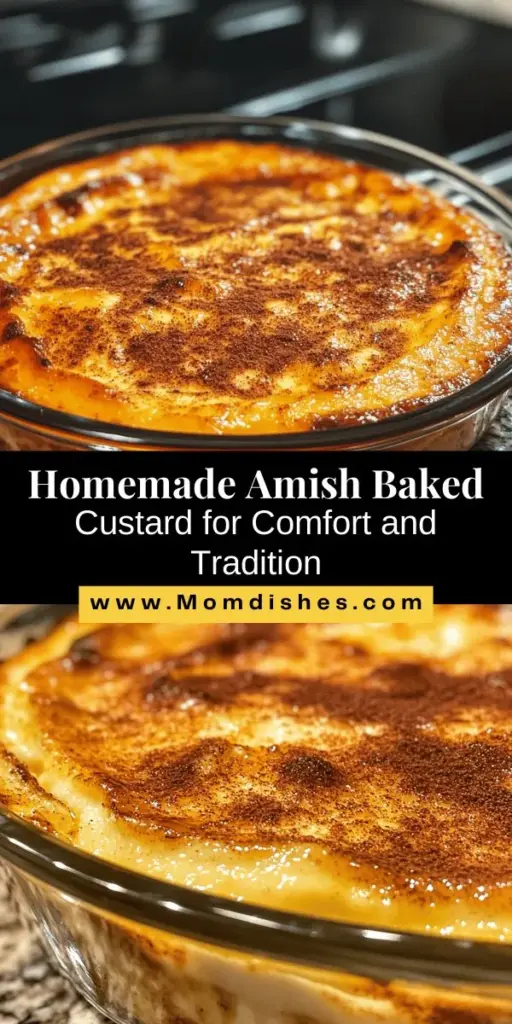Amish cuisine is celebrated for its simplicity, heartiness, and the comforting homestyle qualities that evoke feelings of warmth and nostalgia. Rooted in traditions that prioritize wholesome ingredients and time-honored cooking methods, Amish recipes often reflect a slower pace of life, where meals are lovingly prepared and shared among family and friends. One such dish that embodies these qualities is the beloved baked custard—a classic dessert that is not only simple to make but also deliciously satisfying.
Baked custard holds a special place in the hearts of many, evoking fond memories of family gatherings, potlucks, and celebrations. It is a dessert that transcends generations, often passed down from mothers to daughters, with each family adding their unique touch. The rich, creamy texture paired with the subtle flavors of vanilla and nutmeg creates a delightful experience that captures the essence of home-cooked goodness. Whether served warm or chilled, homemade custard is sure to bring a smile to the faces of those who indulge in it.
In this article, we’ll take a closer look at how to make homemade Amish baked custard, exploring the essential ingredients and the preparation steps that lead to this comforting dessert.
Understanding the Ingredients
To create the perfect Amish baked custard, it’s essential to understand the role of each ingredient in the recipe. The foundation of this classic dish lies in its simple yet high-quality components that work together to produce a creamy, flavorful custard.
Key Ingredients
1. Whole Milk: The base of the custard, whole milk is crucial for achieving a rich, creamy texture. The fat content in whole milk contributes to the custard’s smoothness and helps create that luxurious mouthfeel that is so characteristic of baked custard. While lower-fat milk can be used, it may result in a thinner consistency and a less indulgent flavor.
2. Eggs: Eggs are the backbone of any custard recipe, serving both as a thickening agent and a source of richness. When baked, the proteins in eggs coagulate, transforming the mixture into a silky custard. For the best results, use large, fresh eggs to ensure proper binding and an optimal texture.
3. Granulated Sugar: Sugar adds sweetness to the custard, balancing the flavors and enhancing the overall taste. It is important to use granulated sugar for even dissolution in the mixture. The amount of sugar can be adjusted according to personal preference, but a balanced sweetness is essential for a harmonious dessert.
4. Vanilla Extract: Vanilla is the star flavoring in this baked custard. Using pure vanilla extract, rather than imitation vanilla, elevates the taste and adds a delightful aroma to the final dish. The warmth of vanilla complements the creaminess of the custard beautifully.
5. Nutmeg: A traditional spice in custard recipes, nutmeg adds a warm, aromatic flavor that enhances the dessert’s complexity. A little goes a long way, so be sure to measure it carefully. Nutmeg can also be sprinkled on top of the custard before serving for an elegant touch.
6. Salt: While it may seem counterintuitive to add salt to a sweet dish, a pinch of salt is essential in balancing flavors and enhancing the overall taste of the custard. It helps to round out the sweetness and brings forward the richness of the other ingredients.
7. Optional Ingredients: For those looking to experiment with flavors, cinnamon is a fantastic addition. A sprinkle of cinnamon can enhance the warmth and aromatic qualities of the custard, making it even more inviting. You can also consider adding a splash of almond extract for a unique twist on the classic flavor profile.
Preparation Steps
Now that we understand the key ingredients that make up Amish baked custard, let’s delve into the preparation process. Creating this delightful dessert involves a few straightforward steps that will lead you to a perfectly baked custard.
Preheating the Oven and Preparing the Dish
Before you start mixing your ingredients, the first step is to preheat your oven. Preheating is crucial, as it ensures that the custard cooks evenly throughout, preventing any undesirable texture changes. Set your oven to 350°F (175°C) and allow it to fully preheat while you prepare the custard mixture.
Once the oven is ready, it’s time to prepare your baking dish. A 1-quart baking dish is ideal for this recipe. To ensure that your custard doesn’t stick, greasing the baking dish is essential. Use a thin layer of butter or cooking spray to coat the bottom and sides of the dish evenly. This step not only prevents sticking but also contributes to a beautiful golden exterior.
Mixing the Custard Base
With your oven preheated and your baking dish prepared, it’s time to create the custard base. Start by cracking the eggs into a mixing bowl. For the best results, use a whisk or an electric mixer to beat the eggs until they are well combined and frothy. This process introduces air into the mixture, which will contribute to a light and creamy texture in the final product.
Next, gradually add in the granulated sugar while continuing to whisk the mixture. It’s important to incorporate the sugar thoroughly to ensure that it dissolves completely, as this will enhance the sweetness and smoothness of the custard. The mixture should become pale and slightly thicker.
After the sugar is fully mixed in, it’s time to add the whole milk. To do this, pour the milk slowly into the egg and sugar mixture while whisking continuously. This technique helps to prevent the eggs from curdling, ensuring a smooth custard base. Aim for a gentle, steady stream of milk, mixing as you go to achieve a uniform consistency.
Incorporating Flavorings
Once you have a smooth custard base, it’s time to incorporate the flavorings. Begin by measuring out the vanilla extract, nutmeg, and salt. Add these ingredients to the custard mixture, taking care to combine them evenly. The vanilla will bring a rich aroma, while the nutmeg adds that signature warmth that makes baked custard so comforting.
For those opting to include cinnamon, now is the time to add it as well. A teaspoon of ground cinnamon can provide a delightful hint of spice that elevates the dish. Make sure to mix all the flavorings thoroughly, ensuring that each bite of custard is infused with that deliciousness.
As you prepare your custard, take a moment to appreciate the simplicity of the ingredients. Each element works in harmony to create a dessert that is not only easy to make but also deeply satisfying. The anticipation of baking the custard and filling your home with its delightful aroma is part of the joy of this recipe.
By following these initial preparation steps, you’re well on your way to creating a homemade Amish baked custard that will surely become a cherished family favorite. The next part will delve into the baking process and tips for achieving the perfect custard texture. Stay tuned as we continue this journey into the world of comforting Amish desserts!
{{image_1}}
Preparing the Water Bath
The water bath method, also known as a bain-marie, is essential when baking custard, as it promotes even cooking and helps prevent the delicate texture from cracking. When you place your custard dish inside a larger pan filled with hot water, you create a gentle, moist environment that ensures the custard cooks evenly. This method is particularly important for a dish like Amish Baked Custard, which relies on a smooth, creamy consistency for the best results.
To prepare the water bath, start by preheating your oven to the required temperature, typically around 350°F (175°C). While the oven heats up, fill a larger roasting pan or baking dish with hot water, ensuring the water reaches about halfway up the sides of the custard dish. This hot water not only helps regulate the temperature but also keeps the custard from cooking too quickly, which can lead to curdling or cracks on the surface.
Baking Process
When it comes to baking your custard, timing and temperature are crucial. Setting your oven to the right temperature, usually around 350°F (175°C), ensures that the custard cooks slowly and evenly. The baking process can take anywhere from 45 to 60 minutes, depending on the size of your custard dish and the oven’s calibration.
To determine when your custard is fully baked, keep an eye out for a few signs. The edges should be set, while the center will still have a slight jiggle. A useful technique to check for doneness is the knife test: insert a knife or a thin-bladed spatula into the center of the custard. If it comes out clean or with just a few moist crumbs, your custard is ready. If it comes out with liquid custard clinging to it, give it more time in the oven.
Avoiding overbaking is key to achieving the perfect texture. Overbaking can lead to a rubbery consistency, which is not desirable in a custard. If you notice the edges are browning too much before the center is set, consider lowering the oven temperature slightly or covering the dish loosely with aluminum foil to prevent further browning.
Serving Suggestions
One of the wonderful aspects of Homemade Amish Baked Custard is its versatility in serving. It can be enjoyed warm right out of the oven or chilled in the refrigerator for a refreshing treat. If serving warm, consider allowing the custard to cool for a few minutes before spooning it into bowls, as it will be quite hot.
Garnishing is another opportunity to enhance your custard’s presentation and flavor. A light dusting of ground cinnamon or nutmeg adds a warm spice that complements the sweetness of the custard beautifully. Alternatively, consider serving it with a dollop of whipped cream or a scoop of vanilla ice cream for an indulgent touch.
For those looking to pair their baked custard with complementary desserts, consider light fruit salads or a simple shortcake. Beverages like herbal tea, coffee, or creamy hot chocolate also make excellent companions, providing a delightful contrast to the custard’s rich texture.
Storage and Reheating
Storing leftover baked custard is relatively simple. Once the custard has cooled completely, cover it tightly with plastic wrap or transfer it to an airtight container. It can be kept in the refrigerator for up to three to four days. If you notice any signs of spoilage, such as off smells or changes in texture, it’s best to err on the side of caution and discard it.
When it comes to reheating, the goal is to maintain the custard’s creamy texture. The best method is to reheat it gently in the oven at a low temperature, around 300°F (150°C), until warmed through. This method helps prevent the custard from becoming rubbery. Alternatively, you can microwave it in short intervals, stirring in between to ensure even heating. Just be mindful not to overdo it in the microwave, as custard can easily overcook.
Cultural Significance of Baked Custard
Baked custard holds a special place in Amish culture and traditions, often enjoyed during family gatherings and celebrations. Its simplicity and comforting flavors resonate deeply with the values of togetherness and home-cooked meals that are central to Amish life. Many families have heirloom recipes passed down through generations, each adding their unique twist while maintaining the core elements of the dish.
Personal anecdotes often accompany this beloved dessert: stories of Sunday dinners where baked custard was a staple, shared among family and friends. The custard becomes more than just a dessert; it embodies the spirit of community and shared experiences, evoking memories of laughter and warmth around the dining table.
In broader American cuisine, particularly in Midwest communities, baked custard continues to be a cherished dish. Its enduring popularity speaks to its versatility and the comfort it brings. Through its rich history and the connection it fosters among people, baked custard remains a beloved dessert that transcends generations.
Conclusion
Homemade Amish Baked Custard is a delightful dessert that encapsulates simplicity, warmth, and the rich traditions of family cooking. This recipe not only showcases the ease of preparation but also invites you to connect with heritage and create lasting memories in your kitchen. As you savor each creamy bite, you will find joy in the process of making this timeless treat, reinforcing the importance of homemade desserts in strengthening family traditions. So gather your loved ones, share a slice of this comforting custard, and relish the sweet moments that follow. With each spoonful, you’re not just enjoying a delicious dessert; you’re celebrating a legacy that brings people together, one meal at a time.


